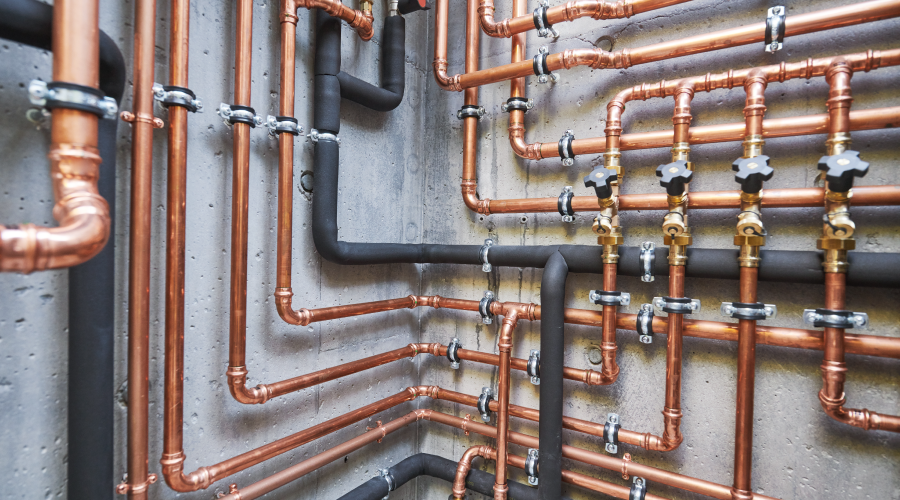Plumbing and Restrooms - Replacement Considerations
Removing and replacing water closets and urinals is an expensive plumbing renovation project. Some older facilities that present problems related to complying with the Americans with Disabilities Act (ADA) are required to renovate the toilet room and update all piping rough-ins and plumbing fixtures. In these cases, a renovation also presents an excellent opportunity to install low-flow, 1.28 gpf fixtures and one-eighth gpf urinals.
Facilities that have old fixtures but that are not required to conduct ADA upgrades still might qualify for a fixture-exchange program from a local utility. These programs help facilities offset the cost of retrofitting old fixtures with new, low-flow fixtures.
Organizations that take a more aggressive approach to sustainability or buildings that are trying to obtain LEED Existing Building certification might need to replace some or all of their existing water closets with low-flow models and change the urinals to one-eighth gpf fixtures.
Prior to such a renovation would be an opportune time to install several waterless urinals as a way to test if they are suitable with the maintenance staff. If they are suitable, managers can choose to specify them in the fixture upgrade.
One inexpensive approach is to change standard flush-meter-type valves or tank-type valves to dual-flush fixtures. When installed, workers will have to adjust them to make sure there is enough water flowing through the fixtures during low-flush situations, which works best with manually operated fixtures.
Sensor-operated Fixtures
Manual-flush toilets are common, but users do not always flush them after use, which can lead to cleanliness and hygiene concerns. Sensor-activated toilets, which do not require the user to touch the fixture, are designed to operate after every use.
One area of concern with some older sensor-operated fixtures is that they can phantom flush, or produce several flushes during one use, which leads to water-efficiency concerns. Technicians can reduce phantom flushes by adjusting the beam on the fixture or by adjusting the infrared sensor. A three-second delay often can address the problem. Some fixtures can activate with a wave of the hand near the flush valve. This feature ensures users do not have to touch the fixture, and it reduces phantom flushes.
Managers also must consider the power source for sensor-activated toilets. Battery-operated fixtures continue to operate when the building loses power, and some recharge with the use of through solar cells or water flow. Such fixtures do not require as many battery changes, with some manufacturers offering a 30-year life.
Lavatory-faucet Options
Before making a decision on retrofitting faucets, managers would be wise to match the most appropriate low-flow lavatory faucet with the correct application. Low-flow faucets are readily available in many price ranges and with many options. Studies have shown that sensor-activated faucets can use more water than manually activated faucets, but they do provide sanitary benefits that generally outweigh the additional water used.
Before installing faucets with flow rates of 0.5-1.8 gallons per minute as standard fixtures, managers should try them out to ensure they meet the organization's approach to sustainability and efficiency. In cases where managers specify sensor-operated fixtures, they might need to adjust housekeeping chemicals and methods to ensure the product's sensor lenses will not be damaged and fail.
Finally, technicians can install low-flow aerators in existing faucets. This tactic is an easy and inexpensive way to reduce the facility's water use. They should change the aerators regularly.
Winston Huff is a project manager, system designer, and sustainability coordinator with Smith Seckman Reid, a consulting engineering firm in Nashville, Tenn.
Restroom Dispensers: Maintenance Matters
Strategic dispenser selection and specification can go a long way toward ensuring clean, comfortable restrooms and minimizing maintenance needs.
For dispensers activated by proximity sensors to work as designed, they must be in good operating condition and have fresh batteries and clean sensors. This approach solves two main issues — hygiene and service — at one time. While manufacturers traditionally have not designed all dispensed restroom products for touch-free applications, the approach is rapidly expanding as manufacturers rush to meet the demand.
Even some toilet-paper dispensers now offer touch-free use. One design uses coreless paper, which is released in a controlled amount by a proximity sensor when the user's hand is in motion below the dispenser's opening. The unit provides one-handed operation, so it complies with the Americans with Disabilities Act (ADA) if installed according to ADA guidelines regarding location and height above the floor.
The operating sensor is located in the dispenser's assembly, so installers can mount it on either side of the stall, and its battery can last up to one year. Installers also can program the paper length, which promotes conservation. Those features contribute to user comfort while at the same time cutting material costs and aiding sustainability efforts.
Touchless, air hand dryers and paper-towel dispensers also are part of this trend. While they have been available for some time, many hand dryers still operate via an activation switch. Managers now can specify designs that require the user to simply touch the paper towel to be dispensed.
Cleaning crews need to make sure the unit's batteries are fresh, the time delay between sheets and the hand-proximity settings are set properly, and installation complies with ADA guidelines — 42-44 inches from the floor to bottom of the unit, with the proper amount of clear floor space around it.
— Thomas A. Westerkamp
|
Related Topics:














